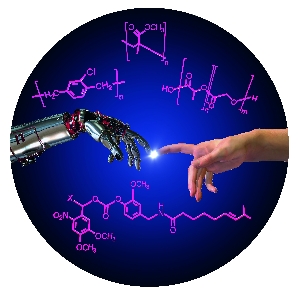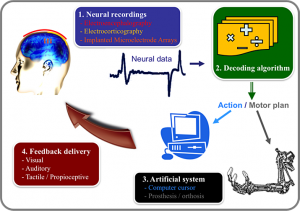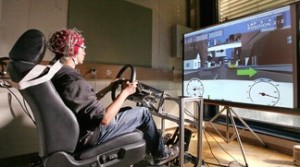
Communication between man and machine – a fascinating area at the interface of chemistry, biomedicine, and engineering. (Figure: KIT/S. Giselbrecht, R. Meyer, B. Rapp)
German researchers from the Karlsruhe Institute of Technology (KIT), Professor Christof M. Niemeyer and Dr. Stefan Giselbrecht of the Institute for Biological Interfaces 1 (IBG 1) and Dr. Bastian E. Rapp, Institute of Microstructure Technology (IMT) have written a good overview of the current state of cyborgs while pointing out some of the ethical issues associated with this field. From the Jan. 10, 2014 news item on ScienceDaily,
Medical implants, complex interfaces between brain and machine or remotely controlled insects: Recent developments combining machines and organisms have great potentials, but also give rise to major ethical concerns. In a new review, KIT scientists discuss the state of the art of research, opportunities, and risks.
The Jan. ?, 2014 KIT press release (also on EurekAlert with a release date of Jan. 10, 2014), which originated the news item, describes the innovations and the work at KIT in more detail,
They are known from science fiction novels and films – technically modified organisms with extraordinary skills, so-called cyborgs. This name originates from the English term “cybernetic organism”. In fact, cyborgs that combine technical systems with living organisms are already reality. The KIT researchers Professor Christof M. Niemeyer and Dr. Stefan Giselbrecht of the Institute for Biological Interfaces 1 (IBG 1) and Dr. Bastian E. Rapp, Institute of Microstructure Technology (IMT), point out that this especially applies to medical implants.
In recent years, medical implants based on smart materials that automatically react to changing conditions, computer-supported design and fabrication based on magnetic resonance tomography datasets or surface modifications for improved tissue integration allowed major progress to be achieved. For successful tissue integration and the prevention of inflammation reactions, special surface coatings were developed also by the KIT under e.g. the multidisciplinary Helmholtz program “BioInterfaces”.
Progress in microelectronics and semiconductor technology has been the basis of electronic implants controlling, restoring or improving the functions of the human body, such as cardiac pacemakers, retina implants, hearing implants, or implants for deep brain stimulation in pain or Parkinson therapies. Currently, bioelectronic developments are being combined with robotics systems to design highly complex neuroprostheses. Scientists are working on brain-machine interfaces (BMI) for the direct physical contacting of the brain. BMI are used among others to control prostheses and complex movements, such as gripping. Moreover, they are important tools in neurosciences, as they provide insight into the functioning of the brain. Apart from electric signals, substances released by implanted micro- and nanofluidic systems in a spatially or temporarily controlled manner can be used for communication between technical devices and organisms.
BMI are often considered data suppliers. However, they can also be used to feed signals into the brain, which is a highly controversial issue from the ethical point of view. “Implanted BMI that feed signals into nerves, muscles or directly into the brain are already used on a routine basis, e.g. in cardiac pacemakers or implants for deep brain stimulation,” Professor Christof M. Niemeyer, KIT, explains. “But these signals are neither planned to be used nor suited to control the entire organism – brains of most living organisms are far too complex.”
Brains of lower organisms, such as insects, are less complex. As soon as a signal is coupled in, a certain movement program, such as running or flying, is started. So-called biobots, i.e. large insects with implanted electronic and microfluidic control units, are used in a new generation of tools, such as small flying objects for monitoring and rescue missions. In addition, they are applied as model systems in neurosciences in order to understand basic relationships.
Electrically active medical implants that are used for longer terms depend on reliable power supply. Presently, scientists are working on methods to use the patient body’s own thermal, kinetic, electric or chemical energy.
In their review the KIT researchers sum up that developments combining technical devices with organisms have a fascinating potential. They may considerably improve the quality of life of many people in the medical sector in particular. However, ethical and social aspects always have to be taken into account.
After briefly reading the paper, I can say the researchers are most interested in the science and technology aspects but they do have this to say about ethical and social issues in the paper’s conclusion (Note: Links have been removed),
The research and development activities summarized here clearly raise significant social and ethical concerns, in particular, when it comes to the use of BMIs for signal injection into humans, which may lead to modulation or even control of behavior. The ethical issues of this new technology have been discussed in the excellent commentary of Jens Clausen,33 which we highly recommend for further reading. The recently described engineering of a synthetic polymer construct, which is capable of propulsion in water through a collection of adhered rat cardiomyocytes,77 a “medusoid” also described as a “cyborg jellyfish with a rat heart”, brings up an additional ethical aspect. The motivation of the work was to reverse-engineer muscular pumps, and it thus represents fundamental research in tissue engineering for biomedical applications. However, it is also an impressive, early demonstration that autonomous control of technical devices can be achieved through small populations of cells or microtissues. It seems reasonable that future developments along this line will strive, for example, to control complex robots through the use of brain tissue. Given the fact that the robots of today are already capable of autonomously performing complex missions, even in unknown territories,78 this approach might indeed pave the way for yet another entirely new generation of cybernetic organisms.
Here’s a link to and a citation for the English language version of the paper, which is open access (as of Jan. 10, 2014),
The Chemistry of Cyborgs—Interfacing Technical Devices with Organisms by Dr. Stefan Giselbrecht, Dr. Bastian E. Rapp, & Prof.Dr. Christof M. Niemeyer. Angewandte Chemie International Edition Volume 52, Issue 52, pages 13942–13957, December 23, 2013 Article first published online: 29 NOV 2013 DOI: 10.1002/anie.201307495
Copyright © 2013 WILEY-VCH Verlag GmbH & Co. KGaA, Weinheim
For those with German language skills,
Chemie der Cyborgs – zur Verknüpfung technischer Systeme mit Lebewesen. by Stefan Giselbrecht, Bastian E. Rapp, and Christof M. Niemeyer. Angewandte Chemie. Volume 125, issue 52, pages 14190, December 23, 2013. DOI: 10.1002/ange.201307495
I have written many times about cyborgs and neuroprosthetics including this Aug. 30, 2011 posting titled: Eye, arm, & leg prostheses, cyborgs, eyeborgs, Deus Ex, and ableism, where I mention Gregor Wolbring, a Canadian academic (University of Calgary) who has written extensively on the social and ethical issues of human enhancement technologies. You can find out more on his blog, Nano and Nano- Bio, Info, Cogno, Neuro, Synbio, Geo, Chem…
For anyone wanting to search this blog for these pieces, try using the term machine/flesh as a tag, as well as, human enhancement, neuroprostheses, cyborgs …
![[downloaded from http://kids.frontiersin.org/articles/brain-machine_interfaces/7/]](http://www.frogheart.ca/wp-content/uploads/2013/11/brain-machineInterface-300x149.png)

